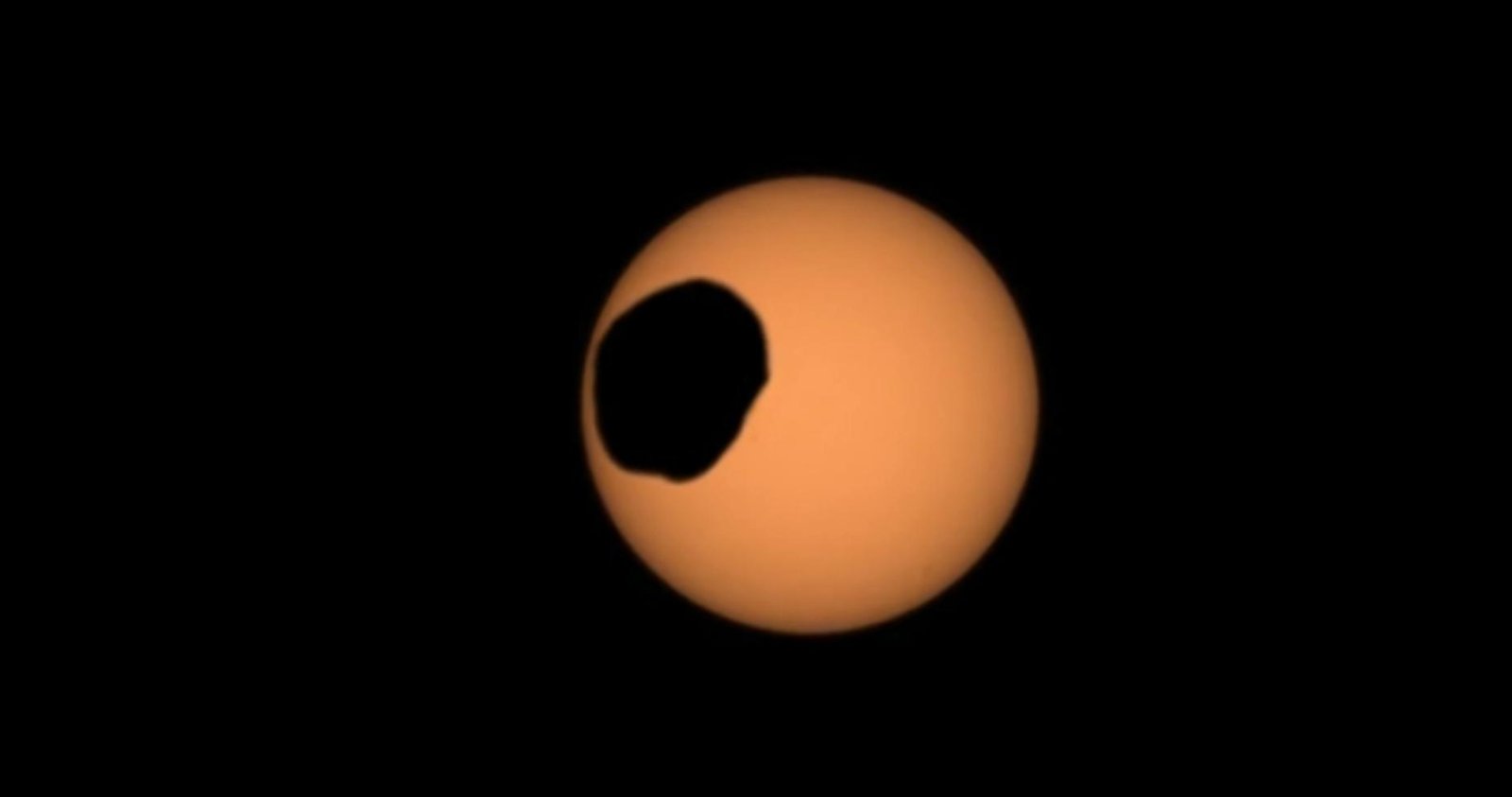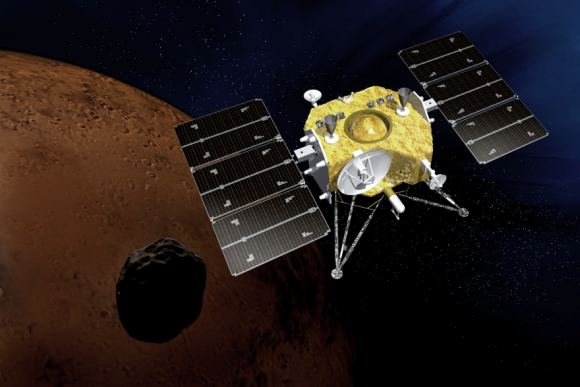As NASA’s Perseverance rover diligently explores the Martian surface, its scientific endeavors extend beyond the red planet itself. One celestial body that has captured the rover’s attention is Phobos, one of Mars’ moons, alongside its counterpart Deimos. These peculiar moons, present a fascinating enigma for scientists, prompting a deeper exploration into their origins, composition, and potential future.

What is Phobos famous for?
Phobos is famous for being one of the two moons of Mars, the other being Deimos. These moons are often referred to as “potato-shaped” and have captured the attention of scientists due to their peculiar characteristics.
Who is Phobos named for?
Phobos is named after the Greek god of fear, Phobos, who is also a son of Ares (the Greek counterpart of the Roman god Mars). In Greek mythology, Phobos is associated with fear and panic.
The Oddities of Phobos and Deimos
To comprehend the uniqueness of Phobos, it is essential to understand its peculiar characteristics. Both Phobos and Deimos share an irregular, lumpy appearance, earning them the endearing label of “potato-shaped.” The proximity of these moons to Mars, coupled with their relatively small size for primary moons, raises intriguing questions about their origins.
Captured Objects
Scientific consensus suggests that Phobos and Deimos are likely captured objects—either asteroids or remnants of debris from the early days of the Solar System. Their small size and proximity to Mars contribute to this hypothesis, with the moons appearing as celestial hitchhikers captured by the red planet’s gravitational pull.
Tidally Locked
An additional layer of complexity arises from the fact that both moons are tidally locked to Mars. This means that, much like Earth’s Moon, they consistently present the same face to the planet they orbit. The tidally locked nature adds a layer of intrigue to their formation and evolution, prompting scientists to delve deeper into the mechanisms behind this phenomenon.
Mastcam-Z’s Glimpse into Phobos’ Transit
Recently, NASA’s Perseverance rover utilized its primary science camera, Mastcam-Z, to observe Phobos, Deimos, and even Mercury as they gracefully transited in front of the Sun. This rare celestial ballet provided a unique opportunity to gather valuable data about the moons’ orbits, sizes, and potential interactions with their parent planet.
Capturing the Dance
The animation showcasing Phobos’ transit in front of the Sun unveils the moon’s delicate journey across the Martian sky. This captivating display not only highlights the moons’ aesthetic charm but also serves as a crucial source of information for scientists seeking to understand the intricacies of their orbits.
Circular Orbits and Complex Pasts
Observations of both Phobos and Deimos reveal circular orbits near the Martian equator, indicating a complex history. The possibility of past impacts or the involvement of a third celestial body adds an intriguing layer to the moons’ story, fueling the quest for answers regarding their formation and evolution.
The Duality of Phobos: Capture or Alternate Formation?
As scientists scrutinize the data from Phobos, a dual narrative emerges. On one hand, the moons’ composition aligns with that of carbonaceous chondrite asteroids, reinforcing the captured object theory. Phobos, with its less stable orbit, suggests a relatively recent capture, leading to speculation that Phobos and Deimos may have once been a singular object that fragmented upon capture.
The Challenge to Capture Theory
However, some aspects of Phobos defy the straightforward capture theory. The presence of phyllosilicate minerals shared with Mars itself raises questions about an alternative formation. The hypothesis of a powerful impact, capable of launching Martian debris into orbit, provides an alternative narrative, drawing parallels to the formation of Earth’s Moon.
The Puzzle of Phobos’ Composition
Phobos’ composition, rich in minerals akin to Mars, adds complexity to the puzzle. While the captured asteroid theory remains plausible, the possibility of a significant impact reshaping the moon challenges scientists to explore unconventional scenarios for its formation.
Phobos’ Looming Fate
Beyond its enigmatic origins, Phobos faces a precarious future. As the closest moon to any planet in the Solar System, Phobos is gradually descending in orbit towards Mars. Projections indicate that approximately 50 million years from now, Phobos will breach the Roche limit, leading to a dramatic outcome.
The Roche Limit Dilemma
The Roche limit marks a critical threshold where tidal forces exceed the gravitational self-binding of a celestial body. For Phobos, this poses a significant challenge, as its orbit lowers over time. The inevitable breach of the Roche limit raises two possible outcomes: a direct collision with Mars or fragmentation, forming a dust ring encircling the red planet.
Deimos’ Contrasting Destiny:
In contrast to Phobos, Deimos follows a distinct trajectory. Orbiting at a significantly greater distance—around 23,500 km (14,600 miles)—Deimos is slowly drifting away from Mars. This divergence in fates showcases the dynamic nature of Martian moons and highlights the diverse pathways celestial bodies can take within a planetary system.
What are 5 facts about Phobos?
- Phobos is one of the two moons of Mars, the other being Deimos.
- Both Phobos and Deimos have an irregular, lumpy appearance, earning them the nickname “potato-shaped.”
- Phobos and Deimos are believed to be captured objects, possibly asteroids or remnants of debris from the early Solar System.
- Both moons are tidally locked to Mars, consistently presenting the same face to the planet they orbit.
- Phobos is gradually descending in orbit towards Mars and is expected to breach the Roche limit in approximately 50 million years, leading to a dramatic outcome.
Earth’s Glimpse into Martian Moon Mysteries
NASA’s Mars rovers, over the years, have meticulously documented Phobos and Deimos’ transits. Beyond their visual allure, these observations contribute significantly to our understanding of the moons’ orbits over time. This ongoing effort to monitor and record these transits acts as a vital tool in slowly unraveling the mysteries surrounding Mars and its enigmatic moons.
The Quest for Samples: Russia’s Phobos-Grunt and Japan’s MMX Mission
While visual observations provide valuable insights, the quest for samples remains paramount in unlocking the secrets of Phobos. Russia embarked on the Phobos-Grunt mission in 2011, aiming to collect samples. Unfortunately, technical challenges led to the mission’s demise, underscoring the complexities involved in reaching and obtaining samples from Martian moons.
Phobos-Grunt Setback
The ill-fated Phobos-Grunt mission faced a series of challenges, including failed rocket burns needed to send it to the moon. Ultimately, the spacecraft met its end in the Pacific Ocean. The ambitious mission highlighted the inherent difficulties in exploring and obtaining samples from these distant celestial bodies.

Japan’s Martian Moons eXploration Mission (MMX)
Japan, undeterred by past setbacks, is gearing up for the Martian Moons eXploration mission (MMX), scheduled for launch in 2026. This ambitious mission aims to collect a sample from Phobos and bring it back to Earth in 2031. The success of MMX holds the promise of providing crucial samples that could finally unveil the mysteries surrounding the origins of Mars’ intriguing moons.
Phobos, Mars’ captivating moon, continues to captivate the scientific community with its peculiarities, transits, and imminent fate. The dance of Phobos and Deimos across the Martian sky, documented by NASA’s rovers, provides glimpses into the complex interplay between these moons and their parent planet. As technological advancements pave the way for sample-return missions like Japan’s MMX, the answers to Phobos’ mysteries may soon be within our grasp, unlocking the secrets of this enigmatic moon and shedding light on the broader mysteries of our solar system’s formation.





